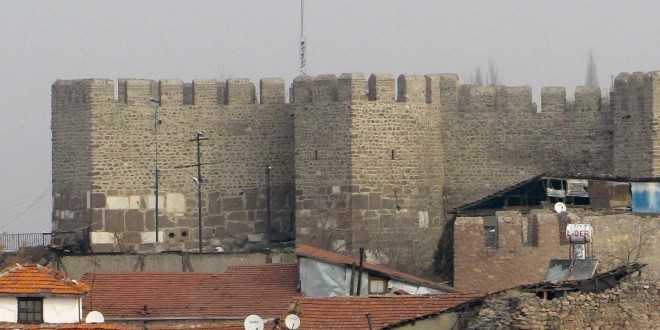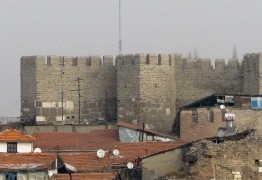We’ve heard it over and over again: Ankara is the most boring place in Turkey. If you’re heading to Capadoccia, take a flight to avoid spending time in Ankara. “How many times can you visit the Ataturk Memorial?” a friend who spent a year there asks rhetorically. Even Frommers guidebook writer, Lynn Levine, half-jokingly titles a section on that city, “Give me One Good Reason to Spend the Night in Ankara.”
Being from the American Midwest, I empathize with places that are considered boring, and last week Sankar and I decided to pay Ankara a sympathy visit.
We’ve been outside Istanbul many times, and I’m familiar with much of the scenery between Turkey’s two biggest cities: wide, exuberant valleys, with rugged mountains in the middle distance. But this time several feet of snow covered the ground. The highway was clear, but stopping at a servis alani, rest stop, for lunch, we saw that plows had not been very successful at clearing parking lots.
Turkish rest stops usually offer several places to eat and sometimes a few shops. But the one at Bolu, about halfway between Istanbul and Ankara, featured close to a dozen restaurants inside a modern outlet mall that even included a hotel.
After we finished a lunch of salad, lentil soup, kebabs and rice pudding, we stopped at a men’s store, where Sankar bought two beautifully-fitting wool-cashmere jackets for about $120.
A few hours later we were in Ankara, using the GPS system to wind our way up to our hotel. We rely on the “Little Hotels of Turkey” guide, and had booked the Angora House hotel: six rooms in an old Ottoman house located within the old Citadel walls. The name Ankara derives from the word angora, which describes both the city’s cats and its sweater-contributing goats.
Typically, our GPS failed us at the very end of our journey, and we had to resort to the humiliating practice of hiring a taxi cab and following it to our destination.The taxi stopped outside the gate. . .
. . . and we maneuvered our car inside (steering around this attractive young family) and along the rutted, icy road several blocks to our hotel.
We were the only guests, and the friendly young manager darted around turning on heat and lights. The rooms had dark woodwork and ceilings, richly colored kilim rugs, and pale bedspreads and curtains, the effect cozy.
 |
| Angora House |
 |
| Room decor |
 |
| Hotel sitting room
|
It was late afternoon and museums were closing, so we wandered into some nearby antique and fabric shops. We found them remarkably light on the junk seen in Istanbul’s tourist areas.
 |
| Interesting shops |
 |
| Lamp made from old tea samovar |
That evening we met Istanbul friends Burcu and Gokhan for dinner at a traditional restaurant. As it was a Thursday night and off-season, we had the restaurant to ourselves. I admired the dark woodwork and traditional Turkish curtains–both charming and kitschy, and so different from what we see in Istanbul–but while taking a photo, managed to drop my camera into the hummus. Fortunately, no damage.
 |
| Typical Turkish lace |
 |
| Gokhan and Burcu ready to dig into some mezzes |
“Where are you staying,” the restaurant manager asked us as he handed us our menus, and when we told him the Angora House, he asked how we liked it. “Fine, but it is a little cold,” I blurted. “I am going to call your hotel about that,” he replied, to my surprise. Indeed, when we got back to our room, an extra heater was in place, running on high, and our room was toasty. Gosh.
The next day we dutifully headed to several museums. The Museum of Anatolian Civilizations is widely touted as the best museum in Turkey. If our expectations of Ankara were low, our expectations of that museum were high. The collection is located inside a lovely 15th century caravansaray/covered bazaar, but we found its exhibits a little dispiriting. A large portion of the museum was under renovation, and items had been moved around to the extent that our audio tour made little sense. I had hoped to gain some sense of the chronology of Turkey’s many historical periods, but that was difficult. To make matters worse, the museum guides strolled around in a tight group talking and laughing, and when I visited the ladies room, a male and female guide were sitting in the anteroom canoodling.
After a disappointing hour and a half, we took a taxi up to the 15th century Haci Bayram Mosque. Built in the 15th century in the Selcuk style, when representations of plants and animals were popular, it is said to be one of Ankara’s most important mosques.
As we got out of the car, I recalled hearing the prayer call just a few minutes earlier, which meant that the mosque would be closed for a half hour. Indeed, we saw people approaching the mosque from all directions, a strikingly devotional scene that we don’t normally witness in Istanbul. To pass time, we went to a nearby tea house and and drank some sahlep, a Turkish winter drink made from powdered orchid roots. But when we emerged, prayers were still in progress. And then we realized that it was the holiest time of the week, Friday noon, and that the services would be longer.
 |
| Come, ye faithful |
We walked closer to the building, hoping for a peek inside when services ended. But there were people crowded around the entrances, women entering the adjacent mausoleum, and men outside kneeling on plastic prayer mats.
 |
| Winter prayers |
This scene more than any other, showed us the sharp differences between Anatolian Turkey, stolid and devout, and European Istanbul with its stylish women and sarkuteri (liquor stores) anchoring street corners. To better fit in with the people milling around me, I pulled my scarf over my head. It was an excellent defense against the brisk weather, and I kept it on.
Instead of standing in the cold waiting for services to end, we headed to the Ethnographic Museum, located on another hilltop in a pretty yellow marble building. This modest endeavor turned out to be a delight, with attentive docents and sweet exhibits of traditional Turkish life.
Late in the afternoon, one of Sankar’s Ankara colleagues picked us up for dinner. Cagatay (pronounced CHA ah tie) went to graduate school in Texas and then lived for six years in Ohio and North Carolina. He is a superb navigator of Turkish and American cultures, equally at ease describing the flaws in Turkey’s education system and his love of the television show, Walking Dead.
Riding with Cagatay, we were able to see some of modern Ankara. The city has a much more open layout than Istanbul (the lack of waterways helps), but on the roads, lane markings are largely absent and traffic does not move well. I attribute some of this (in Istanbul as well) to Turks’ tolerance of drivers who feel they have a right to back up in the middle of traffic, perform U turns on narrow roads and make extreme lane changes. It is a fine example of Turkish bigheartedness, but causes a lot of lost time.
Our first stop was to gaze over some trees at Anitkabir, the huge, memorial to Kemal Ataturk that is reminiscent of the Parthenon. Then we were off to an elegant new Marriott hotel near embassy row, that appeared to be made entirely of marble. We took an elevator to the 22nd floor and enjoyed cocktails and hors d’ouevres overlooking the city. I was surprised to learn that, with over four million people, Ankara’s metropolitan area is the size of greater Boston. Then we headed to an Italian restaurant in the elegant Cankaya neighborhood. It is rare to find ethnic food in Turkey as Turks love to eat their own cuisine when they dine out, so this was a treat.
Cagatay’s wife, Sibel, just returning from a business trip to Paris, joined us at the restaurant. After a delicious meal, she asked if we wanted to go back to their apartment for coffee. We demurred, they both insisted, and we went back and forth a few times. “Well, if you’re really tired,” Sibel finally said, and wanting to disguise the fact that we are boring, decades-older Midwesterners, we agreed.
It was 10:00 pm as we left the restaurant, and in the car, Sibel asked if we would like a chocolate souffle.
Huh? “You’re not going to cook us a souffle at this hour!” I protested. “Oh no,” she said. “We have a bakery in our apartment lobby that delivers . . . I’ll order some.” She phoned the bakery, and within a half-hour we were enjoying a late-night chat and nibbling on rich, warm desserts.
Before we drove out of town the next morning, we walked a few blocks in our ancient neighborhood and climbed to the top of the Citadel to take pictures. Ankara’s Citadel is believed to have been built by the Galatians, a Celtic warrior clan. These are Turkey’s redheads, with whom I surely share some DNA. As I stood at the highest point in the city, I imagined myself one of those long-ago people. . .
 |
| . . . the Galatian fort and garrison . . . |
 |
| . . . enemy cannons preparing to aim at the Citadel . . . |
 |
| . . . a black cat: will today’s battle be a success? |
We walked carefully back down the icy Citadel steps, and my thoughts returned to the present and our half-day journey back to Istanbul. It had been a worthwhile trip. We had felt far away from Istanbul. True, Ankara doesn’t have that city’s poetic location nor its sophistication. But it had made a strong showing.








Thanks for giving some blog space to Turkey’s Flyover country! I love the photos and am grateful that the hummus didn’t ruin your camera.
Nice post, Sue! I’ve also heard Ankara is very gray and there’s nothing to see there. Haven’t been there yet, so we’ll see. Next on our travel list is Konya. =)
Great report.i am planning to go in 9/2012.did y drive to hattusas from Ankara?
Great content thanks.
Cheap Mombasa Flight